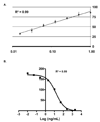Autoantibodies to folate receptor during pregnancy and neural tube defect risk
- PMID: 18804286
- PMCID: PMC3998370
- DOI: 10.1016/j.jri.2008.08.002
Autoantibodies to folate receptor during pregnancy and neural tube defect risk
Abstract
Periconceptional folic acid can reduce the occurrence of neural tube defects (NTDs) by up to 70%, and autoantibodies for folate receptors (FRs) have been observed in serum from women with a pregnancy complicated by an NTD. This population-based cohort study has examined serum from pregnant mothers for autoantibodies to FRs, antibodies to bovine folate binding protein (FBP), and inhibition of folic acid binding to FR and FBP in association with NTD risk. The mid-gestational maternal serum specimens used for this study were collected during the 15-18th week of pregnancy. Samples were obtained from the California Birth Defects Monitoring Program; 29 mothers had a pregnancy complicated by spina bifida and 76 mothers had unaffected children. The presence of IgG and IgM antibodies to human FR, bovine FBP, and inhibition of folic acid binding to FR and FBP was determined. Higher activity of IgM to FBP in cases verses controls was observed (P=0.04). Higher activity of IgM and IgG autoantibodies to FR was observed (P<0.001 and P=0.04, respectively). Risk estimates at two standard deviations above average control antibody concentrations were OR=2.07 (CI=1.02, 4.06) for anti-FBP IgM, OR=2.15 (CI=1.02, 4.69) for anti-FR IgG and OR=3.19 (CI=1.47, 6.92) for anti-FR IgM. These data support the hypothesis that high titers of antibodies and blocking of folic acid binding to FRs by maternal serum should be regarded as risk factors for NTDs.
Figures

References
-
- Antony AC, Utley C, Van Horne KC, Kolhouse JF. Isolation and characterization of a folate receptor from human placenta. J. Biol. Chem. 1981;256:9684–9692. - PubMed
-
- Antony AC, Utley CS, Marcell PD, Kolhouse JF. Isolation, characterization, and comparison of the solubilized particulate and soluble folate binding proteins from human milk. J. Biol. Chem. 1982;257:10081–10089. - PubMed
-
- Barber RC, Shaw GM, Lammer EJ, Greer KA, Biela TA, Lacey SW, Wasserman CR, Finnell RH. Lack of association between mutations in the folate receptor-alpha gene and spina bifida. Am. J. Med. Genet. 1998;76:310–317. - PubMed
-
- Berry RJ, Li Z, Erickson JD, Li S, Moore CA, Wang H, Mulinare J, Zhao P, Wong LY, Gindler J, et al. Prevention of neural-tube defects with folic acid in China. China-U.S. Collaborative Project for Neural Tube Defect Prevention [corrected; erratum to be published] N. Engl. J. Med. 1999;341:1485–1490. - PubMed
-
- Botto LD, Yang Q. 5,10-Methylenetetrahydrofolate reductase gene variants and congenital anomalies: a HuGE review. Am. J. Epidemiol. 2000;151:862–877. - PubMed
Publication types
MeSH terms
Substances
Grants and funding
LinkOut - more resources
Full Text Sources
Other Literature Sources
Medical
Miscellaneous

